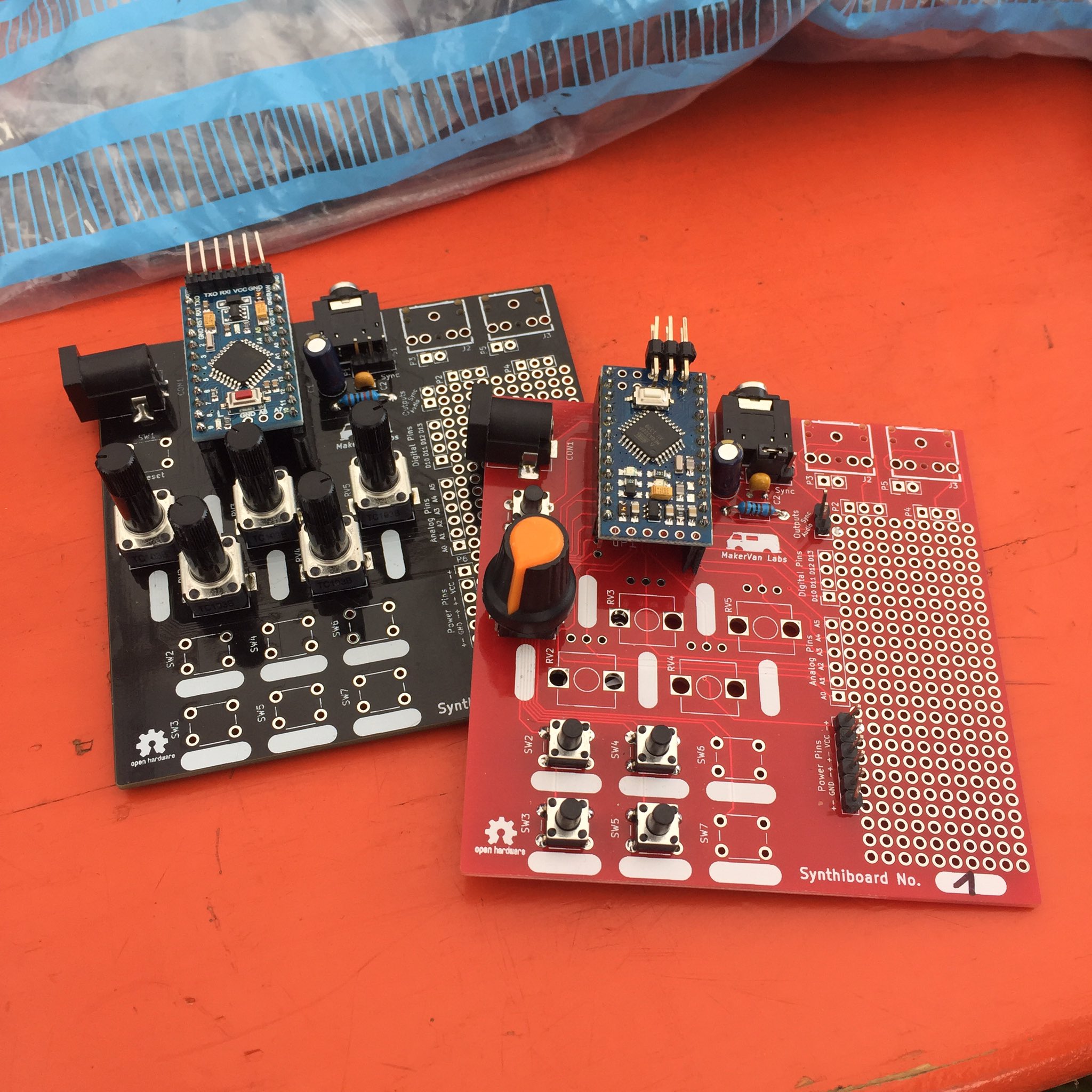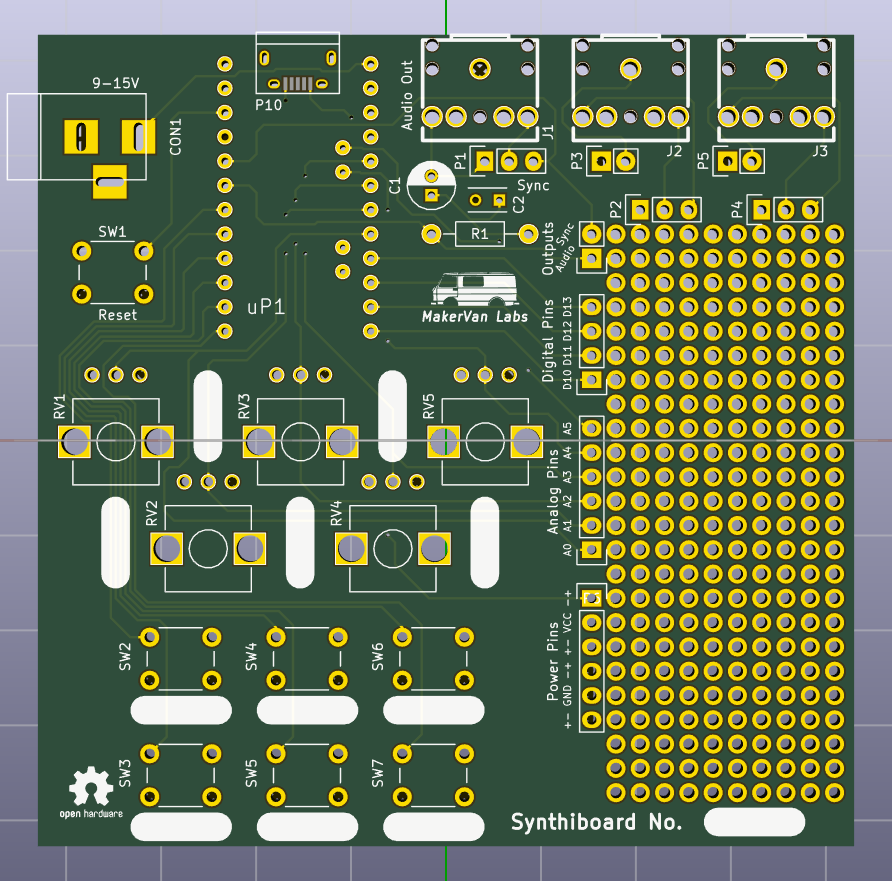Synthiboard
| Synthiboard Release status: stable |
|
|---|---|

|
|
| Description | Synthesizer development board, powered by an Arduino Pro Mini |
| Last Version | 0.1 (2017-08-06) |
| Platform | Arduino Pro Mini |
| License | CC BY-SA 4.0 |
| Download | GitHub |
| Shop | Tindie |


|
|

An Arduino board that can run a number of different synth firmwares (maybe with minor modifications). Bunch of potentiometers, bunch of buttons. And some space to experiment.
The source for hardware and available firmware is up on GitHub now: makervan/synthiboard.
Hardware

We’re using an Arduino Pro Mini as the core of our synth. Input devices are up to 6 buttons and up to 5 potentiometers. Output is done via PWM and a low-pass filter. Unfortunately, there’s not enough oomph on that output to make it work with headphones, you need powered speakers.
The required minimal input configuration depends on the type of firmware you are using (see details below).
There’s a perfboard section of the board that allows you to make your own addons to the synth. Feel free to share your hacks.
Parts
Part |
Partnumber |
Source |
Notes |
|---|---|---|---|
PCB |
Synthiboard v0.1 |
||
Arduino |
Pro Mini, 5V, 16Mhz |
||
Micro USB Connector |
Amphenol ICC (FCI) 10118194-0001LF |
Used for power only |
|
DC barrel jack |
e.g. CUI Devices PJ-002A |
||
3.5mm stereo jack |
CUI Devices SJ1-3525N, Switchcraft Inc. 35RAPC4BHN2 |
min. 1 as output, there's space for two more |
|
Buttons |
Tactile Switch SPST-NO |
There are many different colors available, as well as different
lengths of the button. |
|
Potentiometer |
Bourns Inc. PTV09A-4225F-B103 |
There's space for up to 5 pots on the board |
|
Resistor R1 |
1k Throughhole |
||
Electrolyte capacitor C1 |
10µF radial, 2.0mm leg spacing |
||
Capacitor C2 |
10nF, 2.5/2.54mm leg spacing |
||
Pin headers |
2.54mm single row |
3 pins are necessary for the second channel on the audio out
(sync/audio) |
|
Pin sockets |
2.54mm, single row, 12pin or 2pin |
For socketing the Arduino. Don't forget the two 2-pin headers on the inside of the Arduino board. |
|
FTDI Programming adapter |
To program the Arduino from your computer. If you already have one, you don't need another one. |
Firmwares
There are currently three different firmwares running on the board. They are all in the GitHub repository.
Auduino
The Auduino is a Lo-Fi granular synthesizer, initially developed by Peter Knight. It runs on the Synthiboard pretty much out of the box, but there’s the chance to do some hacks, which we’ll describe in the workshop (and on here sometime soon).
Input Components
- 5 potentiometers
- No buttons.
Drummachine
The Drummachine is a 4 sample 16 slot drum sequencer, based on code written by Sebastian Tomczak, which has been adapted to work with the Synthiboard. The original uses an R2R DAC, the Synthiboard version PWM for audio output instead.
There’s a few hacks for this one as well, which we’ll talk about in the workshop.
Input Components
- 1 potentiometer
- 4 buttons ( + reset)
Glitch Storm
The Glitch Storm is a chiptune synth by Spherical Sound Society. It’s available as a kit on tindie, but runs on the Synthiboard as well (with some minor adjustments). We’re missing the LEDs still, that’s for a future correction.
Input Components
- 3 potentiometers
- 2 buttons ( + reset)
Development
R2R DAC vs. PWM
There are a few ways to generate sound from an Arduino: PWM, a simple R2R DAC, or a dedicated DAC IC.
- https://www.reddit.com/r/AskElectronics/comments/15azgw/what_are_the_pros_and_cons_of_using_an_r2r_vs_a/
- https://electronics.stackexchange.com/questions/188790/signal-generator-pwm-or-r2r
- https://circuitplay.blogspot.de/2013/11/active-filtering-of-arduinos-pwm-output.html
- https://books.google.de/books?id=kK1PCwAAQBAJ&lpg=PA456&dq=sallen-key%20filter%20arduino&hl=de&pg=PA456#v=onepage&q=sallen-key%20filter%20arduino&f=false
Additional Firmware
Drumkid
- Uses 6 buttons (✔), 4 pots (✔), 5 LEDs (✘, could be put on the prefboard section), PWM output (✔)
- HackADay.io Project
- GitHub Repo
- Audio Out PWM uses a different timer and different output pin, so maybe for another HW revision
- maybe we can also add sync out
Helios One
Ellitone Multi-Synth
The Ellitone Multi-Synth is a budget-friendly digital synthesizer that can produce a wide variety of sounds thanks to its 6 selectable synthesis/operation modes. Each of these 6 synthesis/operation modes utilize the instruments 4 knobs, 4 keys, and center patch bay in different ways.
Uses Mozzi library, which uses the “wrong” audio output pin. So it won’t work out of the box, but I’ll give it a shot, and I’ve been thinking about a new hardware revision to address this.
BleepDrum
Mozzi Examples
The Mozzi library has some examples that might be worthwhile to take a look at:
Also there are loads of other synths using Mozzi:
PCB redesign
- Straight ATmega328 instead of ProMini board
- A little more expensive but looks better
- remove the USB port
- more trouble than it is worth
- Battery power (3* AA)
- Also add reverse polarity protection to the DC input jack
- Add option for different PWM pin, to support more synth sketches
- MIDI in, e.g. via 3.5mm jack (TRS): A simplified guide to TRS MIDI
- Use existing 3.5mm jacks, add pinout for optocoupler chip?
- Version using the RPi2040